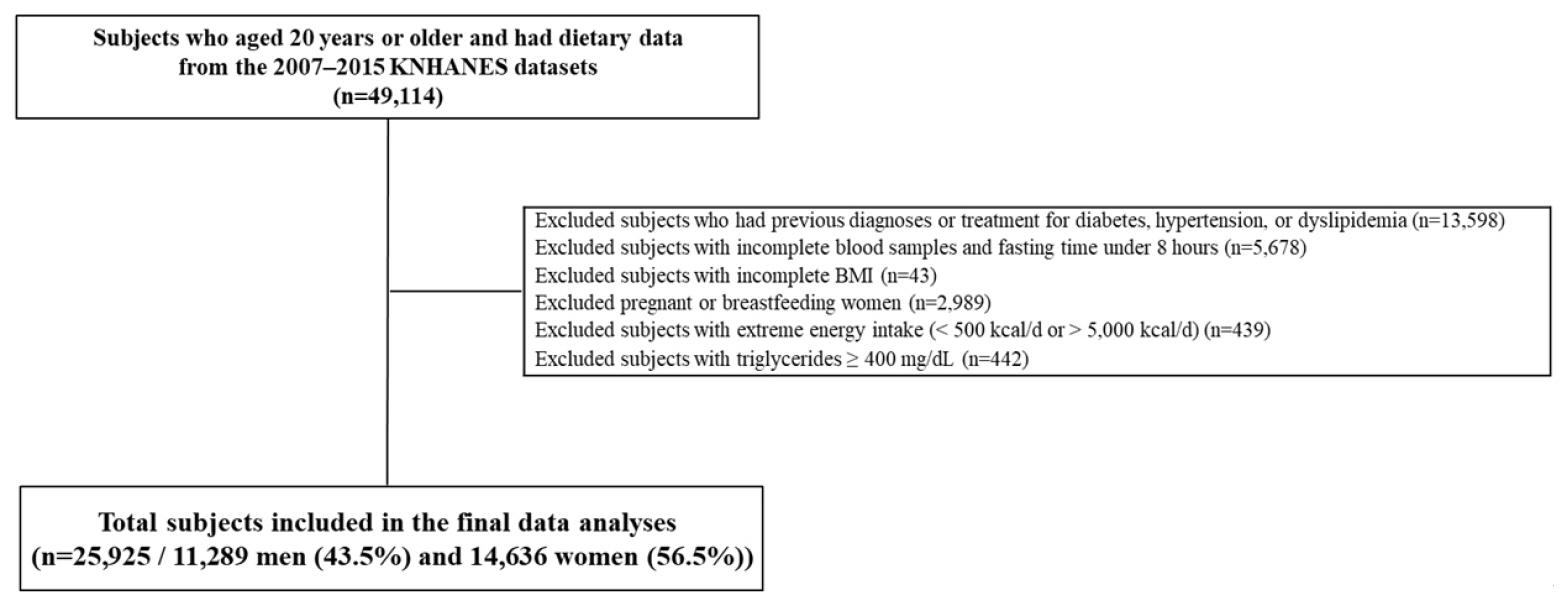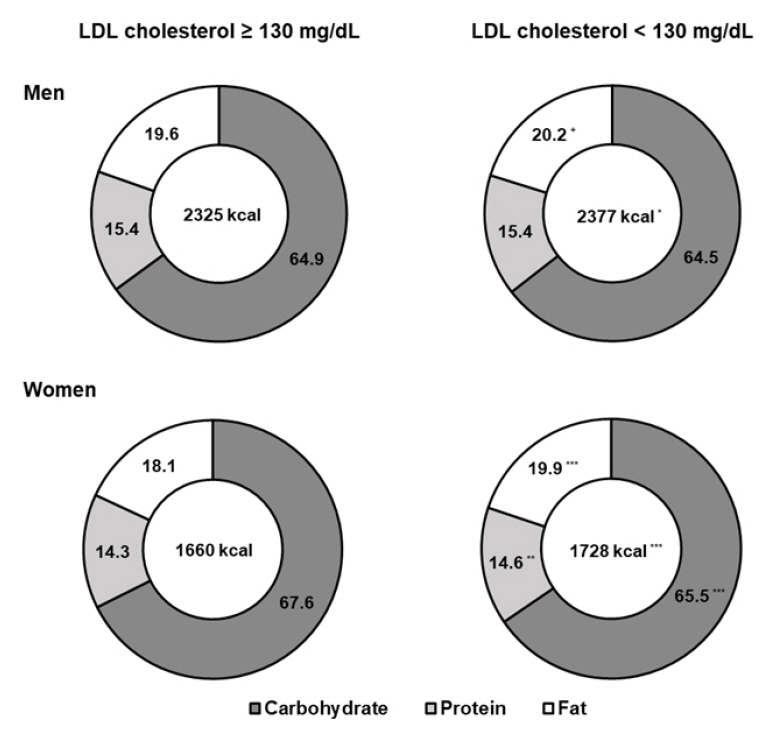Korean J Health Promot.
2020 Dec;20(4):182-193. 10.15384/kjhp.2020.20.4.182.
Association between Dietary Carbohydrate Intake and Cardiovascular Risk Factors According to Low-Density Lipoprotein Cholesterol Levels in Korean Adults
- Affiliations
-
- 1Department of Food and Nutrition, Hannam University, Daejeon, Korea
- 2Department of Food Service and Nutrition Care, Seoul National University Hospital, Seoul, Korea
- 3Department of Food Science and Nutrition, The Catholic University of Korea, Bucheon, Korea
- KMID: 2509875
- DOI: http://doi.org/10.15384/kjhp.2020.20.4.182
Abstract
- Background
Low-density lipoprotein (LDL) cholesterol is a strong predictor of cardiovascular disease, resulting in the promotion of low-fat diets that emphasize the need to lower LDL cholesterol levels. We investigated the relationship between dietary carbohydrate intake and cardiovascular risk factors according to LDL cholesterol levels in Korean adults who typically consumed high-carbohydrate, low-fat diets.
Methods
A total of 25,925 Korean adults were selected from the 2007-2015 Korea National Health and Nutrition Examination Surveys. Dietary carbohydrate intake was grouped into quintiles and cardiovascular risk factors included obesity, metabolic syndrome, type 2 diabetes, and dyslipidemia. Multiple logistic regression models were used to examine association between carbohydrate intake and cardiovascular risk factors by sex and LDL cholesterol levels.
Results
Subjects with LDL cholesterol ≥130 mg/dL had significantly less energy and fat intake than those with LDL cholesterol <130 mg/dL both in men and women. In men, a higher carbohydrate intake was related to increased prevalence of atherogenic dyslipidemia and low high-density lipoprotein (HDL) cholesterol regardless of LDL cholesterol levels. Meanwhile, dietary carbohydrate intake was positively associated with low HDL cholesterol but inversely associated with hypercholesterolemia only in women with LDL cholesterol <130 mg/dL.
Conclusions
High carbohydrate intake in Korean adults is associated with low HDL cholesterol or atherogenic dyslipidemia regardless of LDL cholesterol levels. Carbohydrate intake should be carefully recommended according to the lipid profiles of individuals for the prevention and management of cardiovascular disease.
Figure
Reference
-
1. National Cholesterol Education Program (NCEP) Expert Panel on Detection, Evaluation; Treatment of High Blood Cholesterol in Adults (Adult Treatment Panel III). Third report of the National Cholesterol Education Program (NCEP) expert panel on detection, evaluation, and treatment of high blood cholesterol in adults (adult treatment panel III) final report. Circulation. 2002; 106(25):3143–421.2. Cao Y, Mauger DT, Pelkman CL, Zhao G, Townsend SM, Kris-Etherton PM. Effects of moderate (MF) versus lower fat(LF) diets on lipids and lipoproteins: a meta-analysis of clinical trials in subjects with and without diabetes. J Clin Lipidol. 2009; 3(1):19–32.3. Schwingshackl L, Hoffmann G. Comparison of the long-term effects of high-fat v. low-fat diet consumption on cardiometabolic risk factors in subjects with abnormal glucose metabolism: a systematic review and meta-analysis. Br J Nutr. 2014; 111(12):2047–58.
Article4. Schwingshackl L, Hoffmann G. Comparison of effects of long-term low-fat vs high-fat diets on blood lipid levels in overweight or obese patients: a systematic review and meta-analysis. J Acad Nutr Diet. 2013; 113(12):1640–61.5. Liu J, Wang W, Wang M, Sun J, Liu J, Li Y, et al. Impact of diabetes, high triglycerides and low HDL cholesterol on risk for ischemic cardiovascular disease varies by LDL cholesterol level: a 15-year follow-up of the Chinese multi-provincial cohort study. Diabetes Res Clin Pract. 2012; 96(2):217–24.
Article6. Mora S, Buring JE, Ridker PM, Cui Y. Association of high-density lipoprotein cholesterol with incident cardiovascular events in women, by low-density lipoprotein cholesterol and apolipoprotein B100 levels: a cohort study. Ann Intern Med. 2011; 155(111):742–50.7. Choi H, Song S, Kim J, Chung J, Yoon J, Paik HY, et al. High carbohydrate intake was inversely associated with high-density lipoprotein cholesterol among Korean adults. Nutr Res. 2012; 32(2):100–6.
Article8. Song S, Song WO, Song Y. Dietary carbohydrate and fat intakes are differentially associated with lipid abnormalities in Korean adults. J Clin Lipidol. 2017; 11(2):338–47. e3.
Article9. Feng R, Du S, Chen Y, Zheng S, Zhang W, Na G, et al. High carbohydrate intake from starchy foods is positively associated with metabolic disorders: a cohort study from a Chinese population. Sci Rep. 2015; 5:16919.
Article10. Ha K, Kim K, Chun OK, Joung H, Song Y. Differential association of dietary carbohydrate intake with metabolic syndrome in the US and Korean adults: data from the 2007-2012 NHANES and KNHANES. Eur J Clin Nutr. 2018; 72(6):848–60.
Article11. Song S, Lee JE, Song WO, Paik HY, Song Y. Carbohydrate intake and refined-grain consumption are associated with metabolic syndrome in the Korean adult population. J Acad Nutr Diet. 2014; 114(1):54–62.
Article12. AlEssa HB, Bhupathiraju SN, Malik VS, Wedick NM, Campos H, Rosner B, et al. Carbohydrate quality and quantity and risk of type 2 diabetes in US women. Am J Clin Nutr. 2015; 102(6):1543–53.
Article13. Sluijs I, van der Schouw YT, van der A DL, Spijkerman AM, Hu FB, Grobbee DE, et al. Carbohydrate quantity and quality and risk of type 2 diabetes in the European prospective investigation into cancer and nutrition-netherlands (EPIC-NL) study. Am J Clin Nutr. 2010; 92(4):905–11.
Article14. Yu D, Shu XO, Li H, Xiang YB, Yang G, Gao YT, et al. Dietarycarbohydrates, refined grains, glycemic load, and risk of coronary heart disease in Chinese adults. Am J Epidemiol. 2013; 178(10):1542–9.15. Statistics Korea. Summary report of the cause of death statistics. Daejeon: Statistics Korea;2019.16. Kweon S, Kim Y, Jang MJ, Kim Y, Kim K, Choi S, et al. Data resource profile: the Korea national health and nutrition examination survey (KNHANES). Int J Epidemiol. 2014; 43(1):69–77.
Article17. Rural Development Administration, National Rural Resources Development Institute. Food composition table. 7th ed. Suwon: National Rural Resources Development Institute;2006.18. Rural Development Administration, National Rural Resources Development Institute. Food composition table. 8th ed. Wanju: National Rural Resources Development Institute;2011.19. The Korean Nutrition Society. Dietary reference intakes for Koreans 2015. Seoul: Ministry of Health and Welfare & the Korean Nutrition Society;2016.20. Friedewald WT, Levy RI, Fredrickson DS. Estimation of the concentration of low-density lipoprotein cholesterol in plasma, without use of the preparative ultracentrifuge. Clin Chem. 1972; 18(6):499–502.
Article21. International Obesity Taskforce. The Asia-Pacific perspective: redefining obesity and its treatment. Sydney: WHO Western Pacific Region;2000.22. Lee SY, Park HS, Kim DJ, Han JH, Kim SM, Cho GJ, et al. Appropriate waist circumference cutoff points for central obesity in Korean adults. Diabetes Res Clin Pract. 2007; 75(1):72–80.
Article23. Kajingulu MF, Lepira BF, Mbutiwi INF, Makulo JRR, Bieleli E, Nseka MN. The atherogenic dyslipidemia ratio Log (TG)/HDL-C was not associated with urinary albumin excretion rate (Uaer) and increased cardiovascular risk in black patients with type 2 diabetes. World J Cardiovasc Dis. 2016; 6(1):14–20.
Article24. Mansoor N, Vinknes KJ, Veierød MB, Retterstøl K. Effects of low-carbohydrate diets v. low-fat diets on body weight and cardiovascular risk factors: a meta-analysis of randomised controlled trials. Br J Nutr. 2016; 115(3):466–79.25. Jakobsen MU, Dethlefsen C, Joensen AM, Stegger J, Tjønneland A, Schmidt EB, et al. Intake of carbohydrates compared with intake of saturated fatty acids and risk of myocardial infarction: importance of the glycemic index. Am J Clin Nutr. 2010; 91(6):1764–8.
Article26. Jakobsen MU, O'Reilly EJ, Heitmann BL, Pereira MA, Bälter K, Fraser GE, et al. Major types of dietary fat and risk of coronary heart disease: a pooled analysis of 11 cohort studies. Am J Clin Nutr. 2009; 89(5):1425–32.
Article27. Mente A, Dehghan M, Rangarajan S, McQueen M, Dagenais G, Wielgosz A, et al. Association of dietary nutrients with blood lipids and blood pressure in 18 countries: a cross-sectional analysis from the PURE study. Lancet Diabetes Endocrinol. 2017; 5(10):774–87.28. Frost G, Leeds AA, Doré CJ, Madeiros S, Brading S, Dornhorst A. Glycaemic index as a determinant of serum HDL-cholesterol concentration. Lancet. 1999; 353(9158):1045–8.
Article29. Ford ES, Liu S. Glycemic index and serum high-density lipoprotein cholesterol concentration among us adults. Arch Intern Med. 2001; 161(4):572–6.
Article30. Radhika G, Ganesan A, Sathya RM, Sudha V, Mohan V. Dietary carbohydrates, glycemic load and serum high-density lipoprotein cholesterol concentrations among South Indian adults. Eur J Clin Nutr. 2009; 63(3):413–20.
Article31. Siri PW, Krauss RM. Influence of dietary carbohydrate and fat on LDL and HDL particle distributions. Curr Atheroscler Rep. 2005; 7(6):455–9.
Article32. Seidelmann SB, Claggett B, Cheng S, Henglin M, Shah A, Steffen LM, et al. Dietary carbohydrate intake and mortality: a prospective cohort study and meta-analysis. Lancet Public Health. 2018; 3(9):e419–28.
Article33. Rhee EJ, Kim HC, Kim JH, Lee EY, Kim BJ, Kim EM, et al. 2018 Guidelines for the management of dyslipidemia in Korea. J Lipid Atheroscler. 2019; 8(2):78–131.
Article34. Song SJ, Choi HN, Lee SY, Park JM, Kim BR, Paik HY, et al. Establishing a table of glycemic index values for common Korean foods and an evaluation of the dietary glycemic index among the Korean adult population. Korean J Nutr. 2012; 45(1):80–93.
Article35. Ha K, Joung H, Song Y. Inadequate fat or carbohydrate intake was associated with an increased incidence of type 2 diabetes mellitus in Korean adults: a 12-year community-based prospective cohort study. Diabetes Res Clin Pract. 2019; 148:254–61.
Article
- Full Text Links
- Actions
-
Cited
- CITED
-
- Close
- Share
- Similar articles
-
- Low-Carbohydrate Diets in Korea: Why Does It Matter, and What Is Next?
- Blood Triglycerides Levels and Dietary Carbohydrate Indices in Healthy Koreans
- High fiber and high carbohydrate intake and its association with the metabolic disease using the data of KNHANES 2013 ~ 2017
- Effects of Nutrition Education with Intervention Mapping on Cardiovascular Disease Risk Factors in Women with Borderline Dyslipidemia: Analysis According to Menopausal Status
- Changes in the Serum Level of High Density Lipoprotein-cholesterol after Smoking Cessation among Adult Men




